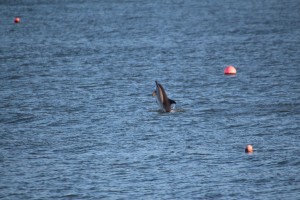Back in December, a lone short-beaked common dolphin was spotted by New Quay resident and gallery owner, Ken Pilkinton. He reported his sighting to Sea Watch Foundation who record whale and dolphin sightings all around the UK, but who have a research base in New Quay.
Usually, this species of dolphin is found in large aggregations offshore in deeper waters, so to see a lone common dolphin in New Quay harbour caused quite a stir amongst the scientists and dolphin-spotters in the area.
The dolphin, nick-named “Stormy” by the Sea Watch volunteers who were observing it in January, was seen on a near daily basis right up until April 15th. It was thought the arrival of its larger cousins, the bottlenose dolphins, may have disrupted it’s now regular pattern and it may have headed out to sea.

‘Stormy’ the short-beaked common dolphin in New Quay harbour photographed by Ken Pilkinton/ Sea Watch Foundation.
“I was browsing my own Facebook newsfeed when I read a friends status update about watching dolphins at sunset from North beach in Aberystwyth. Whilst this wasn’t unusual (we often have bottlenose dolphin sightings from here at this time of year), one of the comments below that caught my eye” says Sea Watch’s Sightings Officer, Kathy James.
“Someone had commented to say ‘have you seen that small dolphin that’s going around and around’. Immediately this made me think of the common dolphin which had shown similar behaviours in New Quay harbour” continues Kathy.
This morning, Kathy headed to Aberystwyth’s North beach to conduct a land-watch and sure enough a dolphin appeared. “I watched the animal for around half an hour as it appeared to feed off Bath Rocks. It certainly seemed smaller than the bottlenose dolphins I’m used to seeing in New Quay and I was almost sure that the dorsal fin was that of “Stormy”. Around twenty minutes into my watch I was rewarded by seeing the distinctive hourglass pattern on the flank of the animal” recalls Kathy.
While Sea Watch can’t be 100% sure that this is the same individual that spent four months around New Quay harbour, it seems an almost definite probability!
It is very important to remember that common dolphins, as well as the bottlenose dolphins we’re more used to seeing, are a European Protected Species. This means that attempting to approach the animal is a prosecutable offence. “We’re really keen that people in Aberystwyth report their dolphin sightings to us at Sea Watch so we can monitor the progress of this and other individuals” adds Kathy.
Aberystwyth is subject to the Ceredigion Marine Code of Conduct which protects marine mammals from being disturbed or harassed. If anyone sees a dolphin disturbance, they should report it to the Cardigan Bay Marine Special Area of Conservation Officer, Melanie Heath (Melanie.Heath2@ceredigion.gov.uk). Any deliberate disturbances can be reported directly to the police. With all eyes on this unusual visitor, Sea Watch and the Special Area of Conservation Officers are hoping that members of the public will inform each other to keep well clear of this wild animal.
Sea Watch Foundation monitors whales, dolphins and porpoises all over the UK. Using their huge data set they are able to inform policy on how best to conserve these species given all the changes happening around our coasts. Sea Watch were instrumental in the designation of two Special Areas of Conservation within Cardigan Bay and utilise public sightings to help them achieve such goals.
Sightings of whales, dolphins and porpoises can easily be submitted online at www.seawatchfoundation.org.uk/sightingsform/ and you can also find out more information about the work of the charity and species fact files too.
To volunteer to conduct land-watches or to become more involved with the work of Sea Watch locally, email mathew.clough@seawatchfoundation.org.uk.
























